Fabrication and Characterisation of Aligned Discontinuous Carbon Fibre Reinforced Thermoplastics as Feedstock Material for Fused Filament Fabrication
Abstract
:1. Introduction
2. Materials and Methods
2.1. Matrix Selection Process
- From a product engineering perspective, the cost, density, stiffness and strength were considered. A lower density results in a lower overall weight and lower material costs are beneficial to reduce development costs and final filament costs. As the mechanical properties of the finite product are mainly driven by the reinforcement fibres, the strength and stiffness of the matrix itself are less important. Mechanical properties such as fracture toughness or brittleness of the polymer may be considered for specific performance requirements but for this initial selection these properties are left out.
- The thermal properties of the matrix are important to consider in the material trade-off as they influence the FFF process. Ideally, the matrix material should have a low processing temperature to reduce energy costs and a high usage temperature, however, these are conflicting requirements. For the trade-off, the melt temperature could not be used as amorphous polymers do not have a distinct melt temperature, and instead increasingly soften above their glass transition temperature Tg. To compare both semi-crystalline and amorphous polymers, the well-documented processing temperature is used. This is a relevant material characteristic which gives a good comparison of the average processing temperature required for different types of polymers.
- The glass transition temperature is a property of both semi-crystalline and amorphous polymers that relates to softening of the polymer. Above the glass transition temperature polymers lose their rigidity are not suitable for structural use.
- The specific heat capacity and thermal conductivity are included in the trade-off as they influence the heating and associated softening of the material. If the material has a high specific heat capacity and high thermal conductivity, more heat initially must be added to soften the polymer. The benefit of this is that more heat can be distributed after deposition between the printed tracks to improve the polymer sintering process [31]. Having a high specific heat capacity and thermal conductivity is therefore beneficial to the FFF process.
- The coefficient of thermal expansion (CTE) relates to the amount of shrinking as the material cools. This can create residual stresses in the 3D printed part and therefore a low CTE is preferred.
- The linear shrinkage expressed as % of the material from melt processing conditions to final cooled part is compared as a metric for minimising residual stresses. This is different than the CTE as other effects (such as crystallisation) may influence shrinkage [32].
- The crystallinity of the polymer is an important parameter for 3D printing that influences the melt behaviour of the material. FFF works best with polymers that are amorphous, despite their lower mechanical performance, as they have no distinct melting point and increasingly soften (lower viscosity) with increasing temperature. This means the polymer sintering process happens over a longer time when cooling down [31].
- The polymer sintering process is related to material flow and the reptation time, which is the time required to create a fully welded, entangled interface. Reptation theory predicts that the reptation time is dependent on temperature and the molecular mass of the polymer. Material flow is related to viscosity, which is a function of temperature and strain rate (process dependent) and the molecular weight as well. These properties cannot be readily compared between polymers, but a simplification is possible to obtain an alternative comparison that is related to these properties. The average moulding pressure is a well-documented property that depends on the processing temperature, viscosity and molecular weight of the polymer. A higher moulding pressure means the polymer, at its processing conditions, flows less easily and thus would have a higher viscosity and longer reptation time. Although no external pressure is applied in the FFF process, the extrusion process is pressure driven and the moulding pressure gives a relative comparison between polymer viscosities which is confirmed later by rheological testing of the candidate polymers.
- The last set of properties that are compared are the printing performance and the interfacial properties with carbon fibres. Some materials already have proven to be processable by FFF while others are less commonly used. In the development of an improved fibre reinforced 3D printing filament, a successful printable material is preferred. Likewise, the interfacial properties with carbon fibres plays an important role to maximise the reinforcing effect of the fibres.
- PLA has the lowest thermal conductivity and specific heat capacity from the common 3D printing polymers, but exhibits good processing temperatures and has a low shrinkage [33]. PLA is a semi-crystalline material and one of the most used 3D printing thermoplastic filaments on the commercial market [4]. The ease with which this material can be printed can be attributed in part to its low shrinkage and good rheological behaviour over a wide temperature range, as seen from its relatively low molding pressure.
- ABS is another widely used thermoplastic filament which has better thermal conductivity properties than PLA, but it is expected to have a higher viscosity which negatively affects bonding [33]. ABS, however, is an amorphous polymer which is advantageous for 3D printing [8,31]. It is known that ABS is best printed in a closed, heated environment as it is sensitive to temperature variations and warping as it has a relatively high CTE [45].
- PETG shows very similar properties as ABS, with a lower viscosity and lower shrinkage which explains its growing popularity as a 3D printing feedstock in recent years [33].
- PA, or commonly known as Nylon, has different grades (PA-66 and PA-6, PA-11, PA-12, etc.). In general, PA shows average properties in all criteria [33]. It has good resistance against oils and common solvents and has good impact resistance and low friction properties. It is mainly used in the transportation sector for non-structural and electronics parts and it is also common in the consumer goods sector. It is known to degrade at higher temperatures and to absorb moisture [46]. It less commonly used as a 3D printing material than ABS, PETG or PLA.
- Polypropylene (PP) is a much used material for general plastic parts and moulding as it is cheap, and resistant to heat and impacts [46]. Despite having a low expected processing viscosity, polypropylene has a relatively high shrinkage and is known to warp during 3D printing. Moreover, the interfacial properties with carbon fibres are expected to be low [47].
- Low density polyethylene (LDPE) and high density polyethylene (HDPE) are two low cost plastic materials that have lower mechanical properties than PP. They are used for cheap consumables such as plastic bags and bottles. They have a high crystallinity and print trials have shown they are hard to print [48]. Another downside of PE are the lower interfacial properties with carbon fibres expected from their molecular structure.
- Polycaprolactone (PCL) is a bio-degradable polymer with a very low melt temperature. Despite the good processing properties such as low viscosity and shrinkage, the low melt temperature of PCL (~55 °C) makes processing harder as solidification increases processing times [33]. It also has a very low Tg and low mechanical properties and therefore is not commonly used for structural parts.
- Polycarbonate (PC) has better mechanical properties than the other commodity polymers and is known for its high impact strength [46]. It shows overall good properties for 3D printing. It has a relatively high processing temperature and a high viscosity, and it is an amorphous polymer which is advantageous for 3D printing.
- Polyvinylchloride (PVC) is another low-cost polymer with a lower processing temperature than PC. It has a high viscosity but low shrinkage [33]. They are mainly used for plastic piping for several applications. Processing of PVC is harder as it release toxins when heated and has several health and safety issues [46].
- Polybutylene terephthalate (PBT) is a semi-crystalline engineering thermoplastic with relatively low cost. It has a relatively high shrinkage but a low expected viscosity [33]. It is often added to filaments to improve the printing quality but is not currently available on the market as filament.
- Polyetherimide (PEI) is common high-end 3D printing material also known as Ultem [49,50]. It is an amorphous polymer with a very low shrinkage and good interfacial properties with carbon fibre [33]. It has a relatively high processing temperature and high viscosity, but additives may be used to improve the flow properties [49,50].
- Polyether ether ketone (PEEK) is a high-performance engineering thermoplastic used in structural applications [46]. Carbon fibre pre-preg tape are available to be used for autoclave processing and recently have been used in Laser Assisted Automated Tape Placement for direct manufacturing of aerospace grade parts [51,52,53]. It has been used in both SLS and FFF processes [32,54,55]. The material trade-off shows it has a high processing temperature, high viscosity, and a higher shrinkage than PEI which makes it less suitable for FFF 3D printing applications [33].
- Polyphenylene sulphide (PPS) is a cheaper high-performance semi-crystalline thermoplastic. It has good mechanical properties and due to its low viscosity it is a preferred choice for high performance carbon fibre thermoplastic composites [56]. For 3D printing applications it has the disadvantage that it has a relatively high processing temperature and shrinkage compared to other materials.
- Polysulfone (PSU) and polyether sulfone (PESU) are relatively new high performance amorphous polymers used in 3D printing [57]. They have a high glass transition temperature and can be used up to 250 °C [46,58] with good mechanical properties. The downside is a relatively high viscosity and processing temperature but low shrinkage.
2.2. Matrix Analysis
2.3. Fibre Reinforcement
2.4. Fibre Alignment Process
2.5. Composite Manufacture
2.6. Mechanical Testing
3. Results
3.1. Mechanical Testing
3.2. Micrographs
4. Discussion
5. Conclusions
Author Contributions
Funding
Conflicts of Interest
References
- Mouritz, A. Introduction to Aerospace Materials, 1st ed.; Woodhead Publishing Ltd.: Cambridge, UK, 2012. [Google Scholar]
- Calignano, F.; Manfredi, D.; Ambrosio, E.P.; Biamino, S.; Lombardi, M.; Atzeni, E.; Salmi, A.; Minetola, P.; Iuliano, L.; Fino, P. Overview on additive manufacturing technologies. Proc. IEEE 2017, 105, 593–612. [Google Scholar] [CrossRef]
- Vasiliev, V.V.; Razin, A.F. Anisogrid composite lattice structures for spacecraft and aircraft applications. Compos. Struct. 2006, 76, 182–189. [Google Scholar] [CrossRef]
- Stansbury, J.W.; Idacavage, M.J. 3D printing with polymers: Challenges among expanding options and opportunities. Dent. Mater. 2016, 32, 54–64. [Google Scholar] [CrossRef] [PubMed]
- Ning, F.; Cong, W.; Qiu, J.; Wei, J.; Wang, S. Additive manufacturing of carbon fiber reinforced thermoplastic composites using fused deposition modeling. Compos. Part B Eng. 2015, 80, 369–378. [Google Scholar] [CrossRef]
- Tekinalp, H.L.; Kunc, V.; Velez-Garcia, G.M.; Duty, C.E.; Love, L.J.; Naskar, A.K.; Blue, C.A.; Ozcan, S. Highly oriented carbon fiber-polymer composites via additive manufacturing. Compos. Sci. Technol. 2014, 105, 144–150. [Google Scholar] [CrossRef] [Green Version]
- Yang, C.; Tian, X.; Liu, T.; Cao, Y.; Li, D. 3D printing for continuous fiber reinforced thermoplastic composites: Mechanism and performance. Rapid Prototyp. J. 2017, 23, 209–215. [Google Scholar] [CrossRef]
- Blok, L.G.; Longana, M.L.; Yu, H.; Woods, B.K.S. An investigation into 3D printing of fibre reinforced thermoplastic composites. Addit. Manuf. 2018, 22, 176–186. [Google Scholar] [CrossRef]
- Brenken, B.; Barocio, E.; Favaloro, A.; Kunc, V.; Pipes, R.B. Fused filament fabrication of fiber-reinforced polymers: A review. Addit. Manuf. 2018, 21, 1–16. [Google Scholar] [CrossRef]
- Wang, X.; Jiang, M.; Zhou, Z.; Gou, J.; Hui, D. 3D printing of polymer matrix composites: A review and prospective. Compos. Part B Eng. 2017, 110, 442–458. [Google Scholar] [CrossRef]
- Justo, J.; Távara, L.; García-Guzmán, L.; París, F. Characterization of 3D printed long fibre reinforced composites. Compos. Struct. 2018, 185, 537–548. [Google Scholar] [CrossRef]
- Lacroix, T.; Tilmans, B.; Keunings, R.; Desaeger, M.; Verpoest, I. Modelling of critical fibre length and interfacial debonding in the fragmentation testing of polymer composites. Compos. Sci. Technol. 1992, 43, 379–387. [Google Scholar] [CrossRef]
- Mallick, P.K. Fiber-Reinforced Composites: Materials, Manufacturing, and Design, 2nd ed.; CRC Press: Boca Raton, FL, USA, 1993. [Google Scholar]
- Piggott, M.R.; Ko, M.; Chuang, H.Y. Aligned short-fibre reinforced thermosets: Experiments and analysis lend little support for established theory. Compos. Sci. Technol. 1993, 48, 291–299. [Google Scholar] [CrossRef]
- Yu, H.; Potter, K.D.; Wisnom, M.R. A novel manufacturing method for aligned discontinuous fibre composites (High Performance-Discontinuous Fibre method). Compos. Part A Appl. Sci. Manuf. 2014, 65, 175–185. [Google Scholar] [CrossRef]
- Tapper, R.J.; Longana, M.L.; Norton, A.; Potter, K.D.; Hamerton, I. An evaluation of life cycle assessment and its application to the closed-loop recycling of carbon fibre reinforced polymers. Compos. Part B Eng. 2020, 184, 107665. [Google Scholar] [CrossRef]
- Tapper, R.J.; Longana, M.L.; Yu, H.; Hamerton, I.; Potter, K.D. Development of a closed-loop recycling process for discontinuous carbon fibre polypropylene composites. Compos. Part B 2018, 146, 222–231. [Google Scholar] [CrossRef] [Green Version]
- Such, M.; Ward, C.; Potter, K. Aligned Discontinuous Fibre Composites: A Short History. J. Multifunct. Compos. 2014, 2, 155–168. [Google Scholar] [CrossRef]
- Yang, D.; Wu, K.; Wan, L.; Sheng, Y. A Particle Element Approach for Modelling the 3D Printing Process of Fibre Reinforced Polymer Composites. J. Manuf. Mater. Process. 2017, 1, 10. [Google Scholar]
- Compton, B.G.; Post, B.K.; Duty, C.E.; Love, L.; Kunc, V. Thermal analysis of additive manufacturing of large-scale thermoplastic polymer composites. Addit. Manuf. 2017, 17, 77–86. [Google Scholar] [CrossRef]
- Bellehumeur, C.; Li, L.; Sun, Q.; Gu, P. Modeling of Bond Formation Between Polymer Filaments in the Fused Deposition Modeling Process. J. Manuf. Process. 2004, 6, 170–178. [Google Scholar] [CrossRef]
- Pollard, D.; Ward, C.; Herrmann, G.; Etches, J. Filament Temperature Dynamics in Fused Deposition Modelling and Outlook for Control. Procedia Manuf. 2017, 11, 536–544. [Google Scholar] [CrossRef]
- Turner, B.N.; Strong, R.; Gold, S.A. A review of melt extrusion additive manufacturing processes: I. Process design and modeling. Rapid Prototyp. J. 2014, 20, 192–204. [Google Scholar] [CrossRef]
- Sun, Q.; Bellehumeur, C.; Gu, P. Effect of processing conditions on the bonding quality of FDM polymer filament. Solid Free. Fabr. Proc. 2002, 14, 400–407. [Google Scholar] [CrossRef]
- McIlroy, C.; Olmsted, P.D. Disentanglement effects on welding behaviour of polymer melts during the fused-filament-fabrication method for additive manufacturing. Polymer 2017, 123, 376–391. [Google Scholar] [CrossRef] [Green Version]
- de Gennes, P.G. Entangled polymers. Phys. Today 1983, 36, 33–39. [Google Scholar] [CrossRef]
- Wool, R.P.; Yuan, B.-L.; McGarel, O.K. Welding of polymer interfaces. Polym. Eng. Sci. 1989, 29, 1340–1367. [Google Scholar] [CrossRef]
- Pabst, W.; Gregorová, E.; Berthold, C. Particle shape and suspension rheology of short-fiber systems. J. Eur. Ceram. Soc. 2006, 26, 149–160. [Google Scholar] [CrossRef]
- Mulholland, T.; Goris, S.; Boxleitner, J.; Osswald, T.; Rudolph, N. Process-Induced Fiber Orientation in Fused Filament Fabrication. J. Compos. Sci. 2018, 2, 45. [Google Scholar] [CrossRef] [Green Version]
- Choy, C.L.; Leung, W.P.; Kowk, K.W.; Lau, F.P. Elastic moduli and thermal conductivity of injection-molded short-fiber–reinforced thermoplastics. Polym. Compos. 1992, 13, 69–80. [Google Scholar] [CrossRef]
- Gibson, I.; Rosen, D.; Stuckers, B. Additive Manufacturing Technologies: 3D Printing, Rapid Prototyping, and Direct Digital Manufacturing; Springer: New York, NY, USA, 2015. [Google Scholar]
- Benedetti, L.; Brulé, B.; Decreamer, N.; Evans, K.E.; Ghita, O. Shrinkage behaviour of semi-crystalline polymers in laser sintering: PEKK and PA12. Mater. Des. 2019, 181, 107906. [Google Scholar] [CrossRef]
- Granta Design Limited. CES EduPack Software; Granta Design Limited: Cambridge, UK, 2019. [Google Scholar]
- Shipton, P.D. The Compounding of Short Fibre Reinforced Thermoplastic Composites. Ph.D. Thesis, Brunel University, Uxbridge, UK, 1988. [Google Scholar]
- Wan, Y.Z.; Wang, Y.L.; Xu, X.H.; Li, Q.Y. In Vitro Degradation Behavior of Carbon Fiber-Reinforced PLA Composites and Influence of Interfacial Adhesion. J. Appl. Polym. Sci. 2001, 82, 150–158. [Google Scholar] [CrossRef]
- Li, J.; Zhang, Y.F. The Tensile Properties of Short Carbon Fiber Reinforced ABS and ABS/PA6 Composites. J. Reinf. Plast. Compos. 2010, 29, 1727–1733. [Google Scholar] [CrossRef]
- C3DXTech. CarbonX Carbon Fiber Reinforced Filament. 2018. Available online: https://www.3dxtech.com/brands/CarbonXTM.html (accessed on 16 May 2018).
- Kausar, A. Design and Study of Epoxy Composites based on Polycaprolactone and Nanodiamond Functionalized Carbon Fibers. Am. J. Polym. Sci. Eng. 2015, 3, 50–60. [Google Scholar]
- Dányádi, L.; Gulyás, J.; Pukánszky, B. Coupling of carbon fibers to polycarbonate: Surface chemistry and adhesion. Compos. Interfaces 2003, 10, 61–76. [Google Scholar] [CrossRef]
- Chen, Y.; Wang, X.; Wu, D. Recycled carbon fiber reinforced poly(butylene terephthalate) thermoplastic composites: Fabrication, crystallization behaviors and performance evaluation. Polym. Adv. Technol. 2013, 24, 364–375. [Google Scholar] [CrossRef]
- Tang, G.; Zang, Z.; Chang, D.; Wei, G.; Wang, D.; Mi, W.; Yan, W.; Huang, W. Study on the Interfacial Behavior of Clay-Coated Carbon Fiber-Reinforced PEI Composites. Polym. Plast. Technol. Eng. 2012, 51, 861–865. [Google Scholar] [CrossRef]
- Gao, S.L.; Kim, J.K. Cooling rate influences in carbon fibre/PEEK composites. Part 1. Crystallinity and interface adhesion. Compos. Part A Appl. Sci. Manuf. 2000, 31, 517–530. [Google Scholar] [CrossRef]
- Liu, B.; Liu, Z.; Wang, X.; Zhang, G.; Long, S.; Yang, J. Interfacial shear strength of carbon fiber reinforced polyphenylene sulfide measured by the microbond test. Polym. Test. 2013, 32, 724–730. [Google Scholar] [CrossRef]
- Hartwig, G.; Jäger, H.; Knaak, S. Interlaminar Shear Strength of Carbon-Fibre Reinforced Thermoplastics Polycarbonate and Polysulfone. In Nonmetallic Materials and Composites at Low Temperatures; Hartwig, G., Evans, D., Eds.; Cryogenic Materials Series; Springer: Boston, MA, USA, 1986. [Google Scholar]
- Weng, Z.; Wang, J.; Senthil, T.; Wu, L. Mechanical and thermal properties of ABS/montmorillonite nanocomposites for fused deposition modeling 3D printing. Mater. Des. 2016, 102, 276–283. [Google Scholar] [CrossRef]
- Biron, M. Thermoplastics and Thermoplastic Composites; Elsevier Science: Amsterdam, The Netherlands, 2007. [Google Scholar]
- Yumitori, S.; Arao, Y.; Tanaka, T.; Naito, K.; Tanaka, K.; Katayama, T. Increasing the interfacial strength in carbon fiber/polypropylene composites by growing CNTs on the fibers. WIT Trans. Model. Simul. 2013, 55, 275–284. [Google Scholar]
- Chong, S.; Pan, G.T.; Khalid, M.; Yang, T.C.K.; Hung, S.T.; Huang, C.M. Physical Characterization and Pre-assessment of Recycled High-Density Polyethylene as 3D Printing Material. J. Polym. Environ. 2017, 25, 136–145. [Google Scholar] [CrossRef]
- Cicala, G.; Ognibene, G.; Portuesi, S.; Blanco, I.; Rapisarda, M.; Pergolizzi, E.; Recca, G. Comparison of Ultem 9085 used in fused deposition modelling (FDM) with polytherimide blends. Materials 2018, 11, 285. [Google Scholar] [CrossRef] [PubMed] [Green Version]
- Zaldivar, R.J.; Witkin, D.B.; McLouth, T.; Patel, D.N.; Schmitt, K.; Nokes, J.P. Influence of processing and orientation print effects on the mechanical and thermal behavior of 3D-Printed ULTEM®9085 Material. Addit. Manuf. 2017, 13, 71–80. [Google Scholar] [CrossRef]
- Telford, R.; Peeters, D.; Oliveri, V.; Zucco, G.; Jones, D.; O’Higgins, R.; Weaver, P.M. Enhanced Buckling Performance of a Stiffened, Variable Angle Tow Thermoplastic Composite Panel. In Proceedings of the 2018 AIAA/ASCE/AHS/ASC Structures, Structural Dynamics, and Materials Conference, Kissimmee, FL, USA, 8–12 January 2018; pp. 1–14. [Google Scholar]
- Comer, A.J.; Ray, D.; Obande, W.O.; Jones, D.; Lyons, J.; Rosca, I.; O’Higgins, R.M.; McCarthy, M.A. Mechanical characterisation of carbon fibre-PEEK manufactured by laser-assisted automated-tape-placement and autoclave. Compos. Part A Appl. Sci. Manuf. 2015, 69, 10–20. [Google Scholar] [CrossRef]
- Ray, D.; Comer, A.J.; Lyons, J.; Obande, W.; Jones, D.; O’Higgins, R.M.; McCarthy, M.A. Fracture toughness of carbon fiber/polyether ether ketone composites manufactured by autoclave and laser-assisted automated tape placement. J. Appl. Polym. Sci. 2015, 132, 1–10. [Google Scholar] [CrossRef]
- Berretta, S.; Davies, R.; Shyng, Y.T.; Wang, Y.; Ghita, O. Fused Deposition Modelling of high temperature polymers: Exploring CNT PEEK composites. Polym. Test. 2017, 63, 251–262. [Google Scholar] [CrossRef]
- Chen, B.; Berretta, S.; Davies, R.; Ghita, O. Characterisation of carbon fibre (Cf)—Poly Ether Ketone (PEK) composite powders for laser sintering. Polym. Test. 2019, 76, 65–72. [Google Scholar] [CrossRef]
- Stoeffler, K.; Andjelic, S.; Legros, N.; Roberge, J.; Schougaard, S.B. Polyphenylene sulfide (PPS) composites reinforced with recycled carbon fiber. Compos. Sci. Technol. 2013, 84, 65–71. [Google Scholar] [CrossRef]
- Kishore, V.; Chen, X.; Ajinjeru, C.; Hassen, A.A.; Lindahl, J.M.; Failla, J.; Kunc, V.; Duty, C.E. Additive manufacturing of high performance semicrystalline thermoplastics and their composites. In Proceedings of the Solid Freeform Fabrication Symposium—An Additive Manufacturing Conference, Austin, TX, USA, 8–10 August 2016. [Google Scholar]
- Zhansitov, A.A.; Khashirova, S.Y.; Slonov, A.L.; Kurdanova, Z.I.; Shabaev, A.S.; Khashirov, A.A.; Mikitaev, A.K. Development of technology of polysulfone production for 3D printing. High Perform. Polym. 2017, 29, 724–729. [Google Scholar] [CrossRef]
- Markforged. High Strength 3D Printing with Continuous Fibres. 2016. Available online: https://markforged.com/ (accessed on 1 November 2016).
- 3D4Makers. 3D4Makers Filament Engineers. Available online: https://www.3d4makers.com/ (accessed on 14 May 2018).
- Valentin, D.; Paray, F.; Guetta, B. The hygrothermal behaviour of glass fibre reinforced Pa66 composites: A study of the effect of water absorption on their mechanical properties. J. Mater. Sci. 1987, 22, 46–56. [Google Scholar] [CrossRef]
- Cox, H.L. The elasticity and strength of paper and other fibrous materials. Br. J. Appl. Phys. 1952, 3, 72–79. [Google Scholar] [CrossRef]
- Longana, M.L.; Ong, N.; Yu, H.; Potter, K.D. Multiple Closed Loop Recycling of Carbon Fibre Composites with the HiPerDiF (High Performance Discontinuous Fibre) Method. Compos. Struct. 2016, 153, 271–277. [Google Scholar] [CrossRef] [Green Version]
- Teijin Carbon. Tenax® Short Fiber Product Data Sheet Chopped Fiber with Thermoplastic Sizing. 2020. Available online: https://www.teijincarbon.com/products/tenaxr-carbon-fiber/tenaxr-short-fibers (accessed on 12 October 2020).
- Campbell, F.C. Manufacturing Processes for Advanced Composites; Elsevier: Oxford, UK, 2004. [Google Scholar]
- Gebart, B.R. Permeability of Unidirectional Reinforcements for RTM. J. Compos. Mater. 1992, 26, 1100–1133. [Google Scholar] [CrossRef]
- Goh, K. Discontinuous-Fibre Reinforced Composites; Springer: London, UK, 2016. [Google Scholar]
- Wagner, T. ParticleSizer. 2016. Available online: https://imagej.net/ParticleSizer (accessed on 12 October 2020).
- Technology Outlet. Premium PET-G Carbon Fibre Filament. 2019. Available online: https://technologyoutlet.co.uk/products/technology-outlet-premium-pet-g-carbon-fibre-filament (accessed on 7 January 2019).
- Technology Outlet. Premium PLA Carbon Fibre Filament. 2019. Available online: https://technologyoutlet.co.uk/products/carbon-pla-3d-printer-filament (accessed on 7 January 2019).
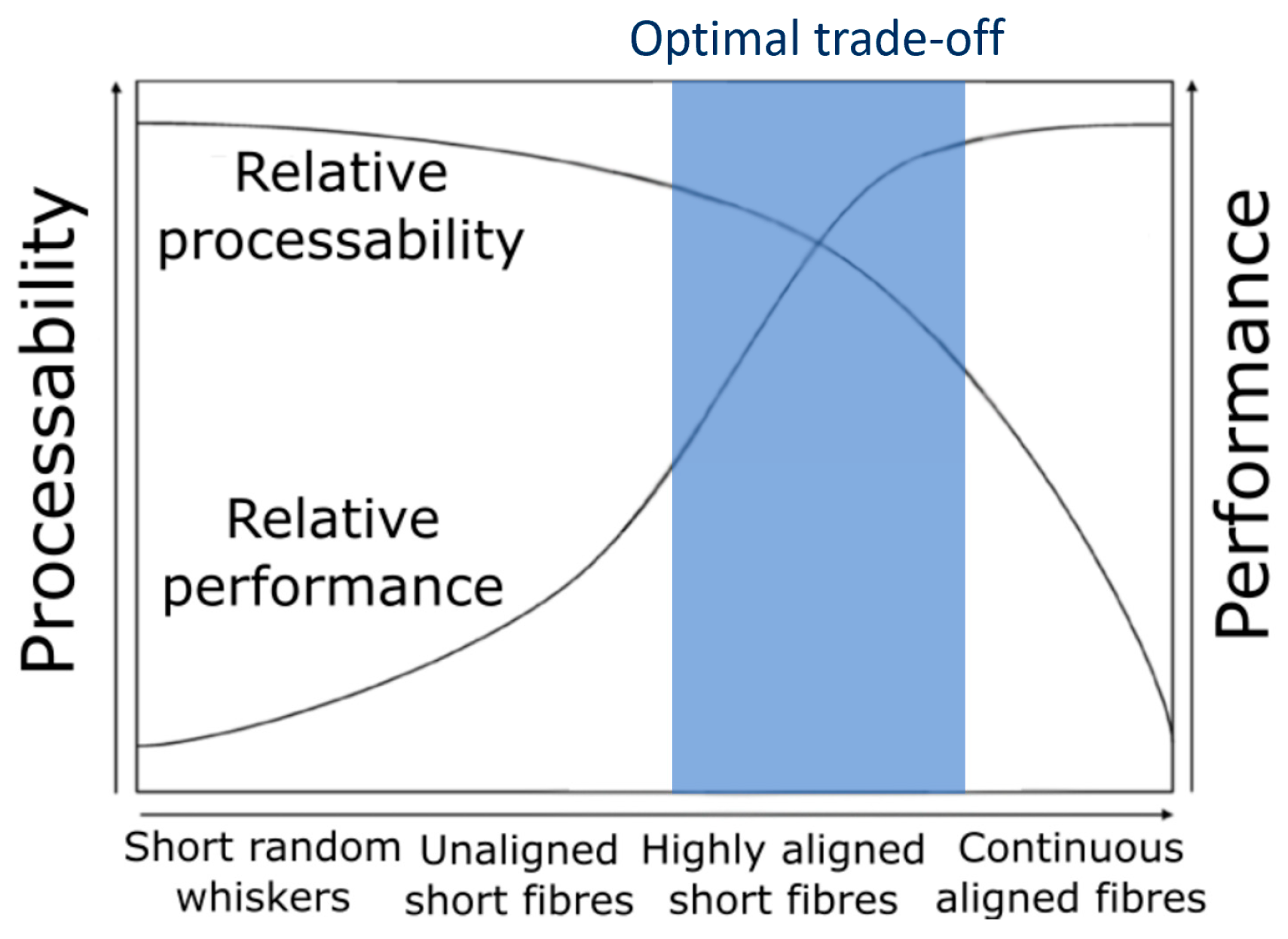


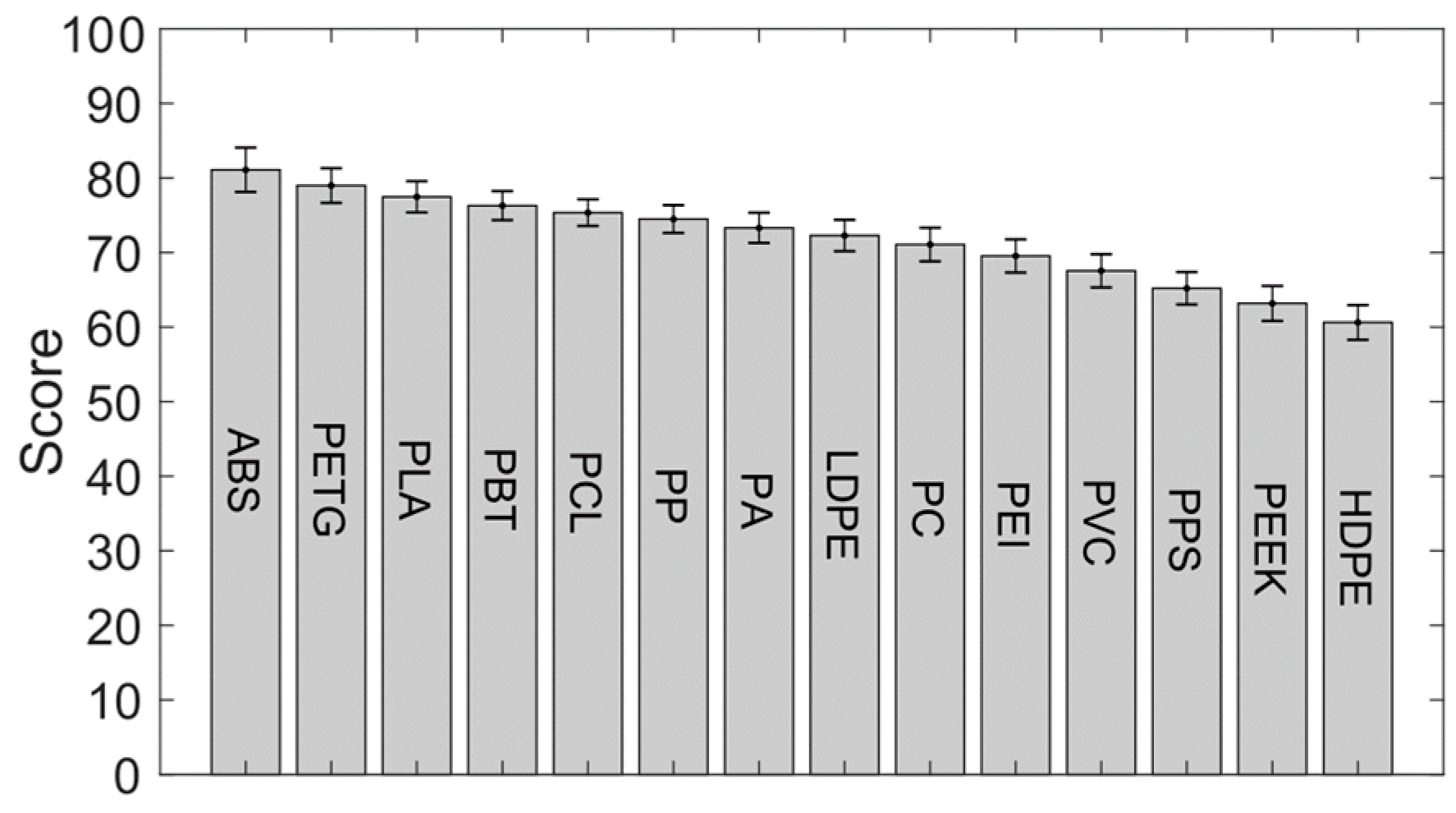
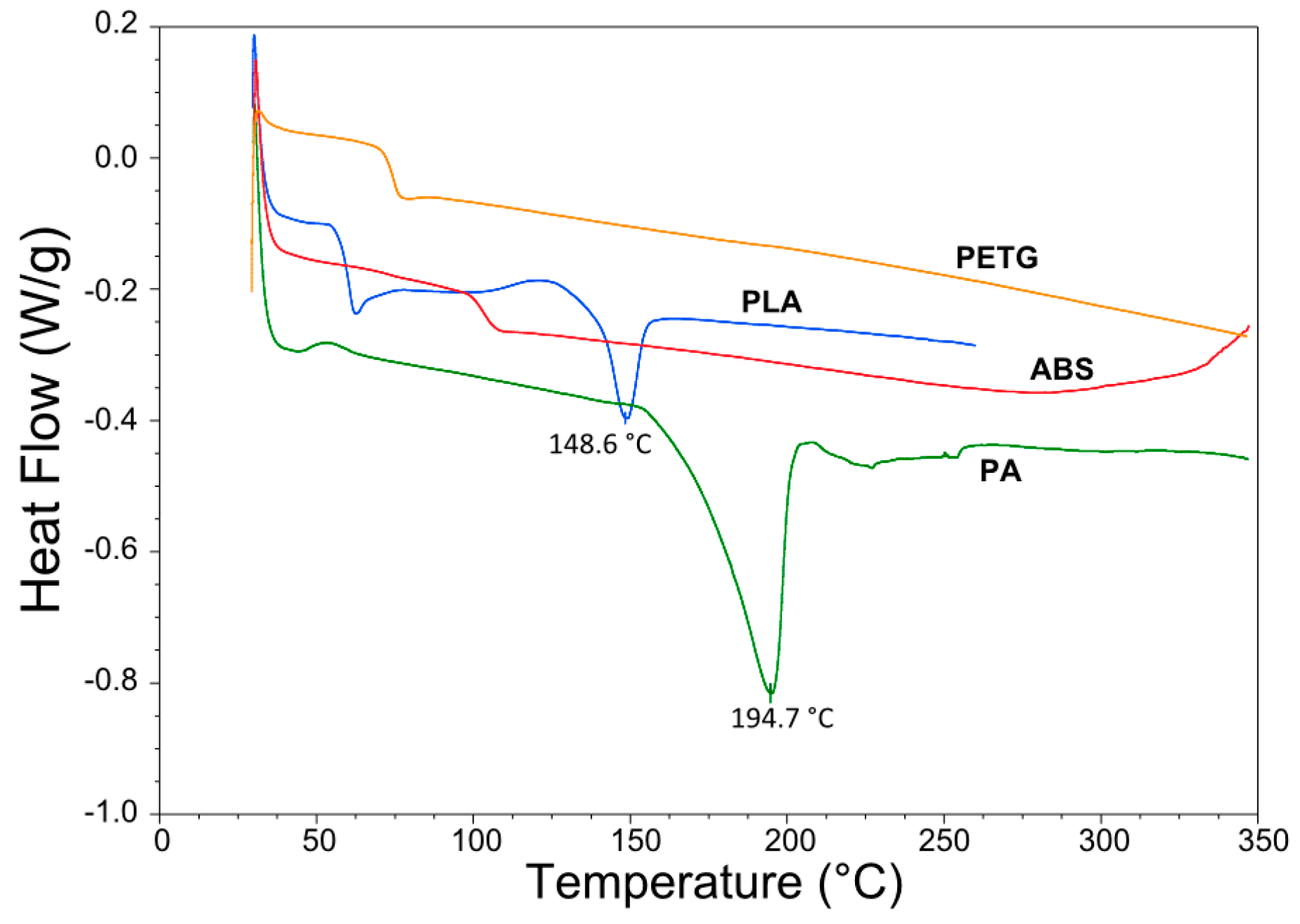

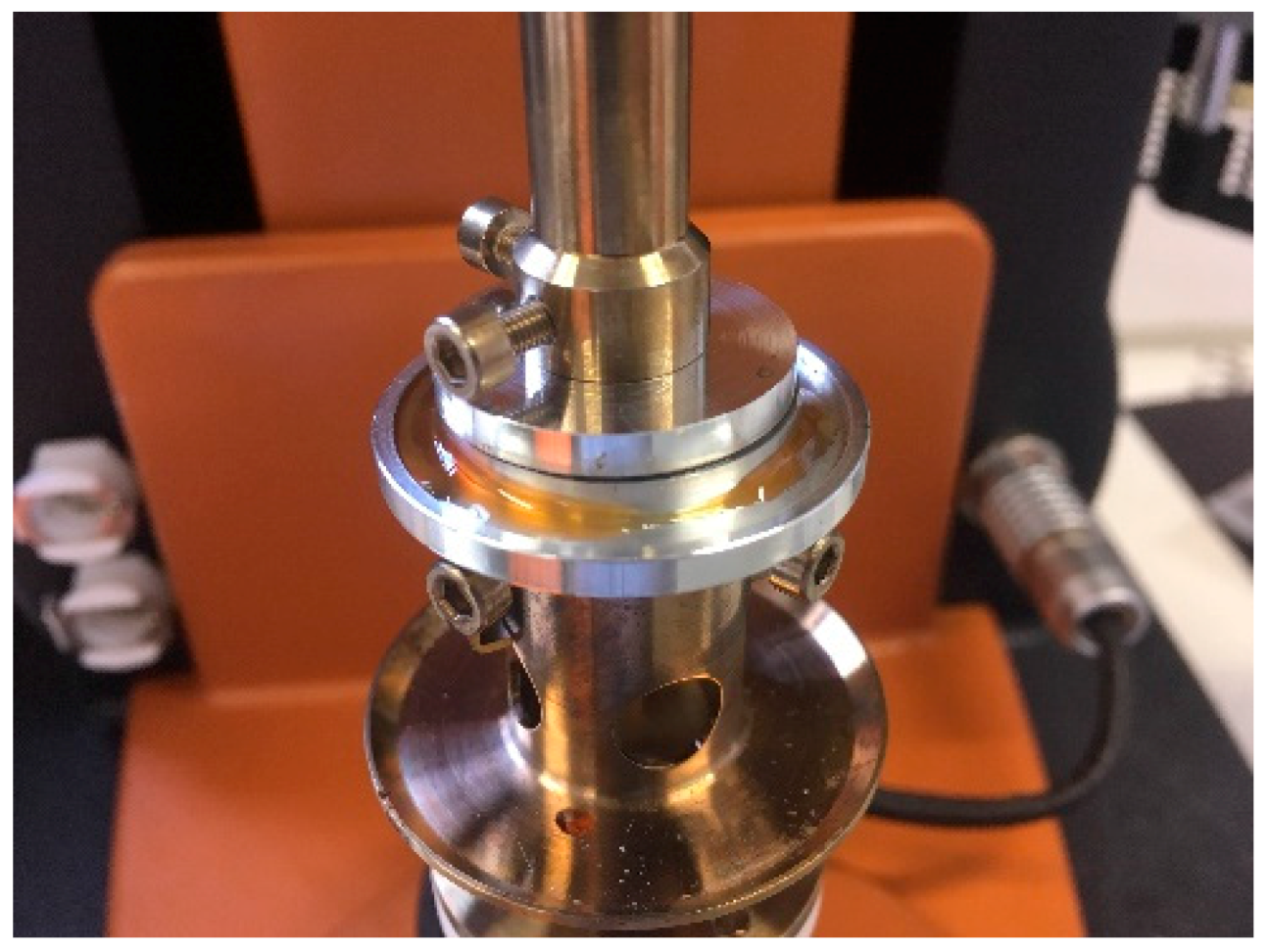

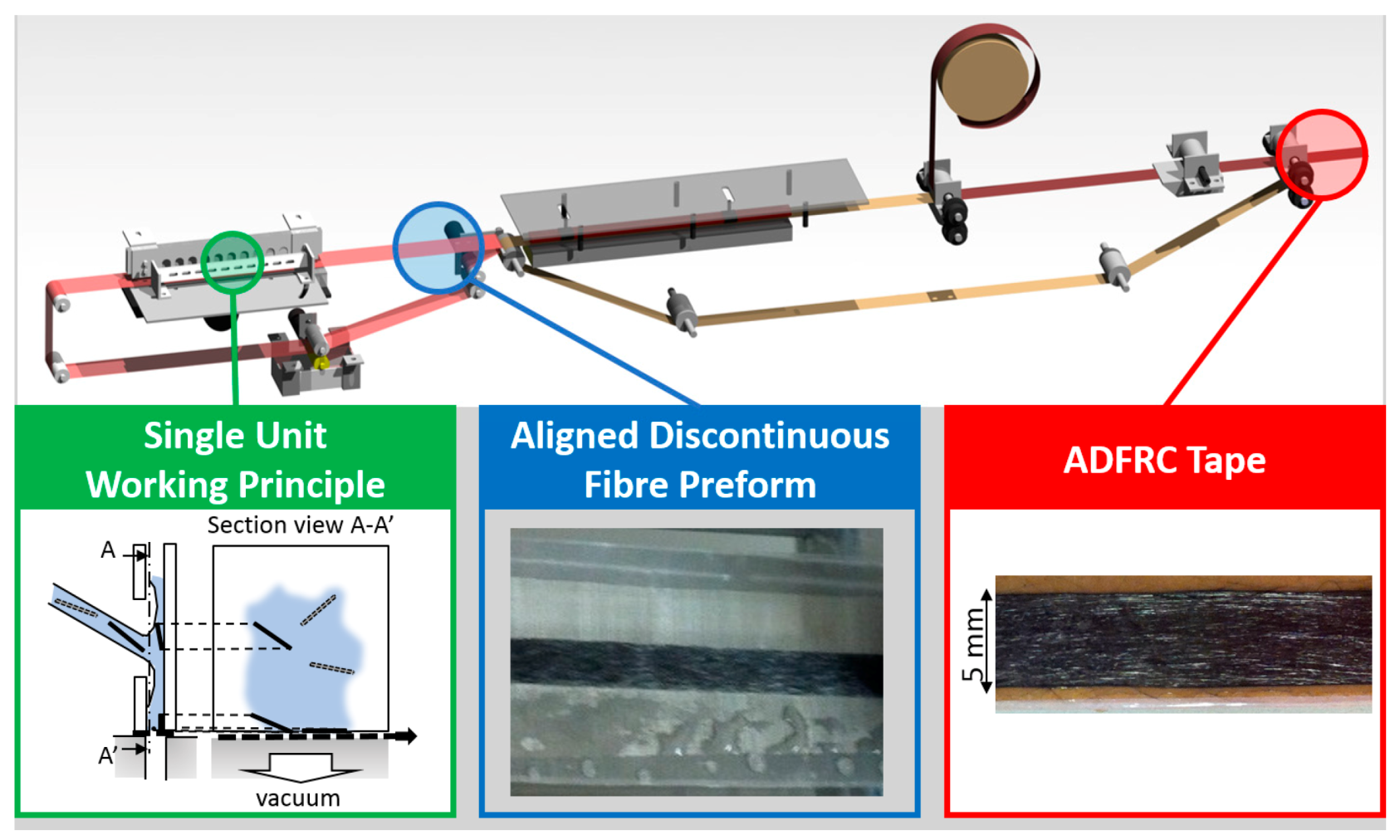

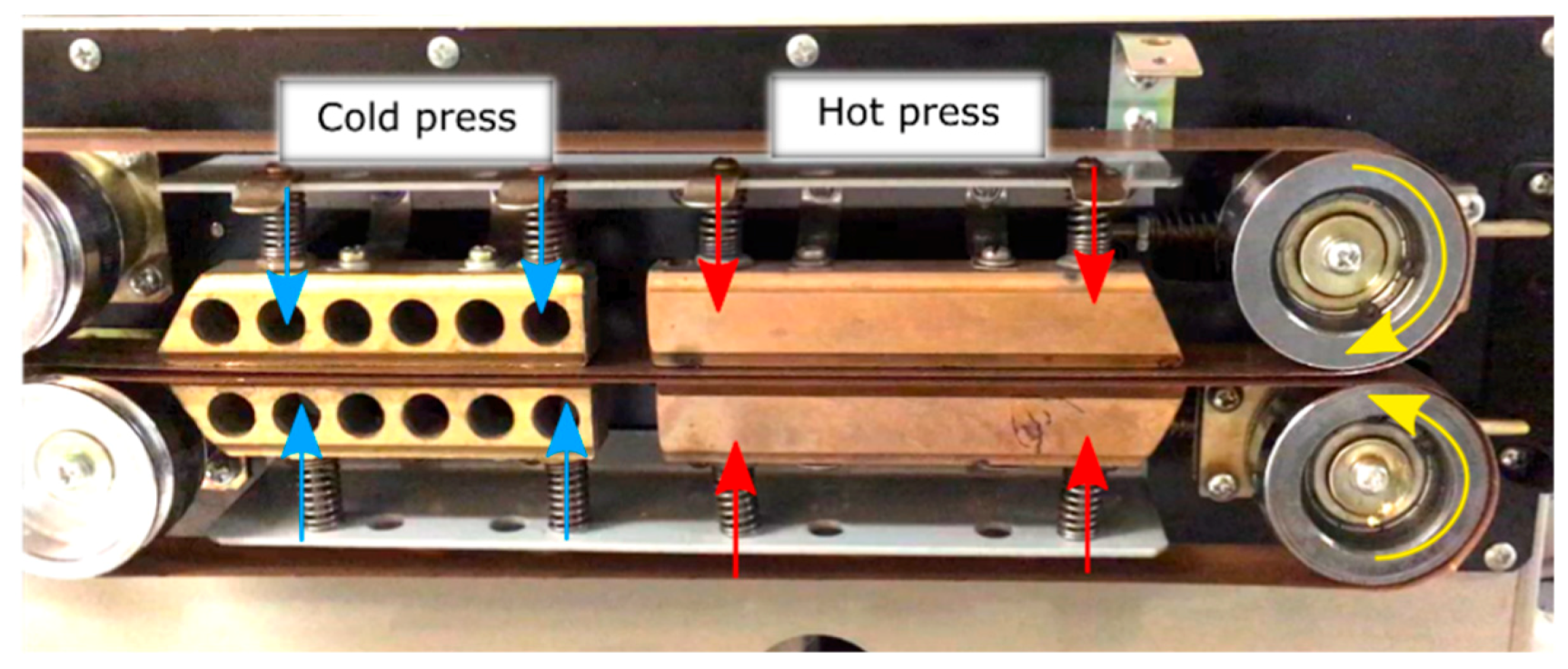

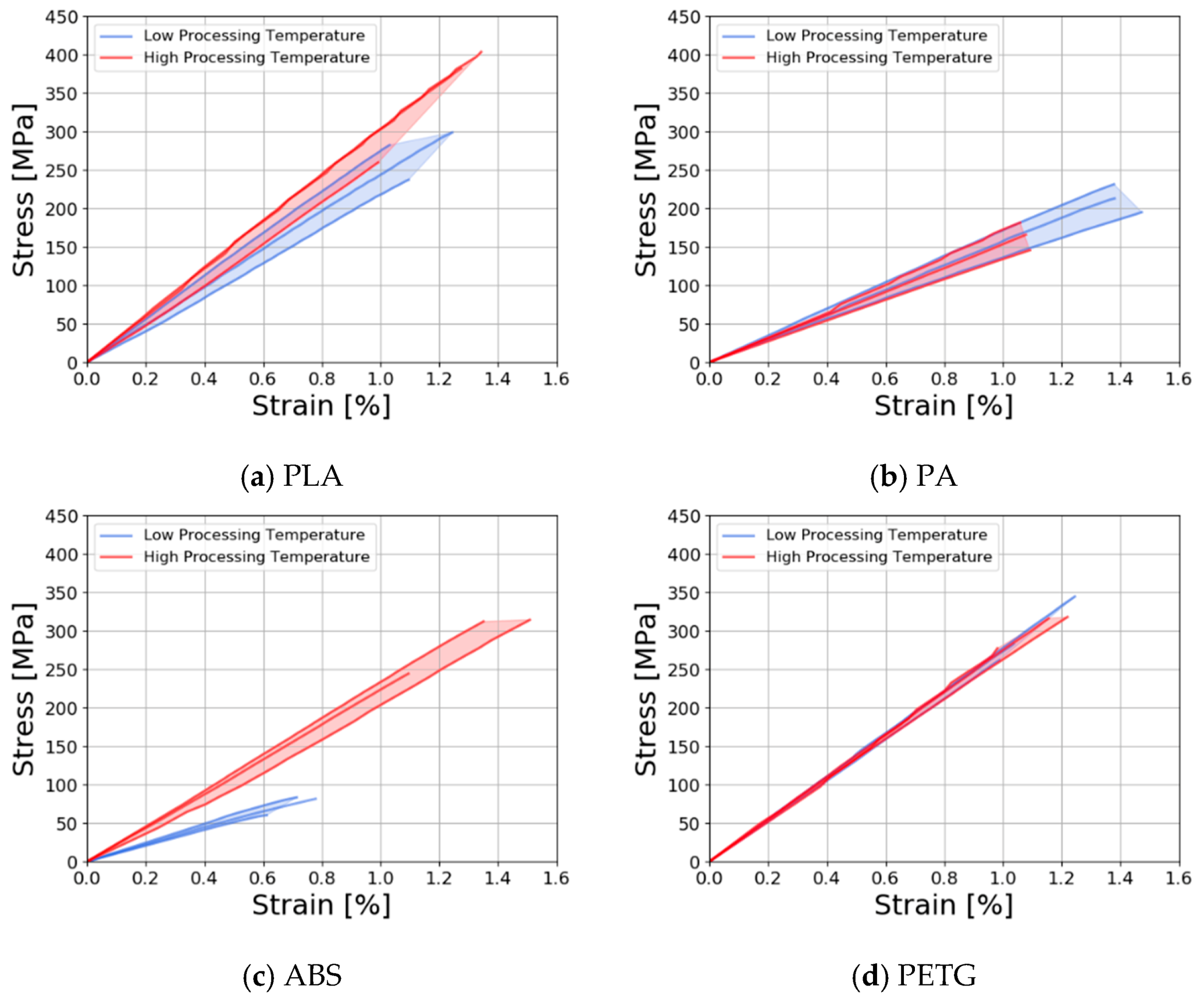
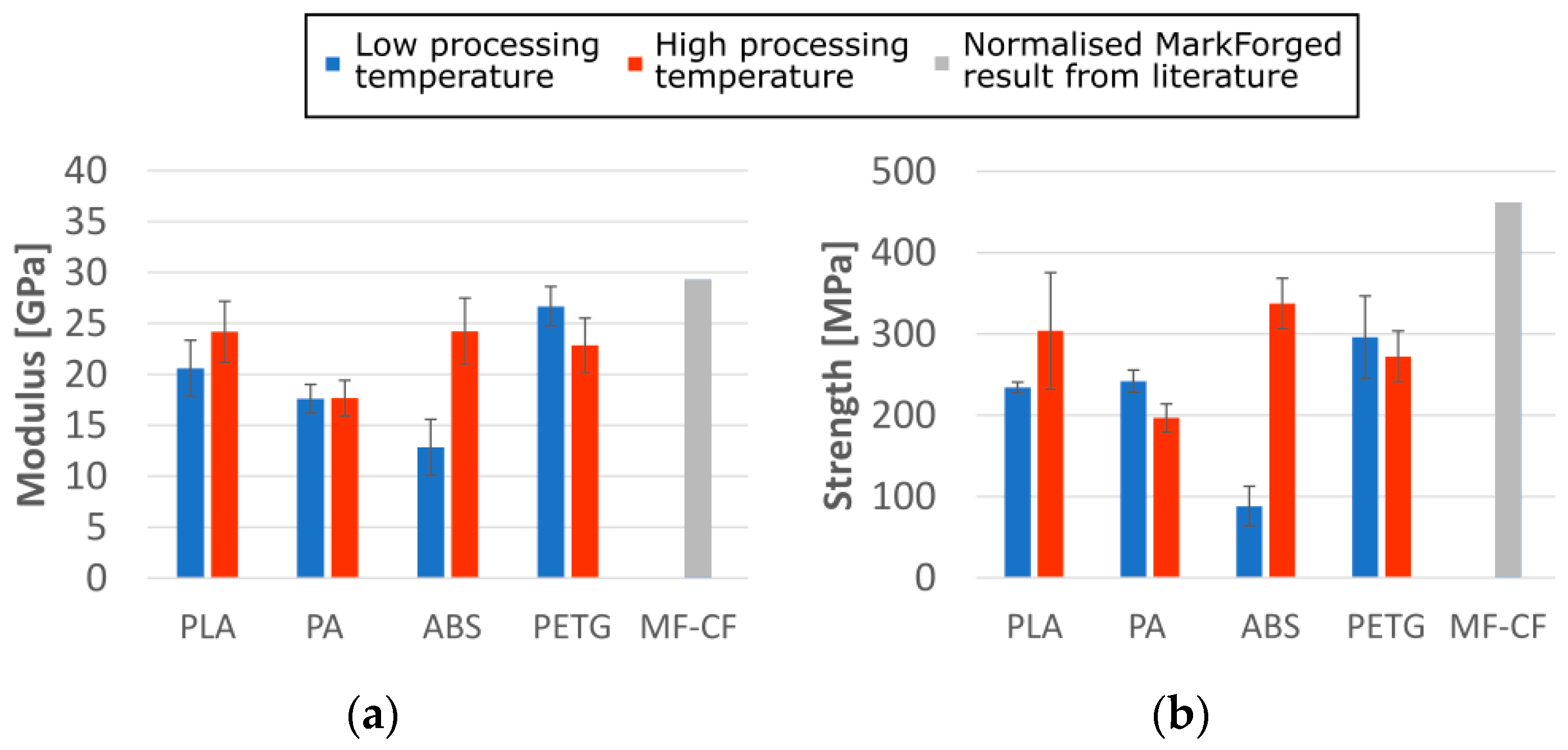
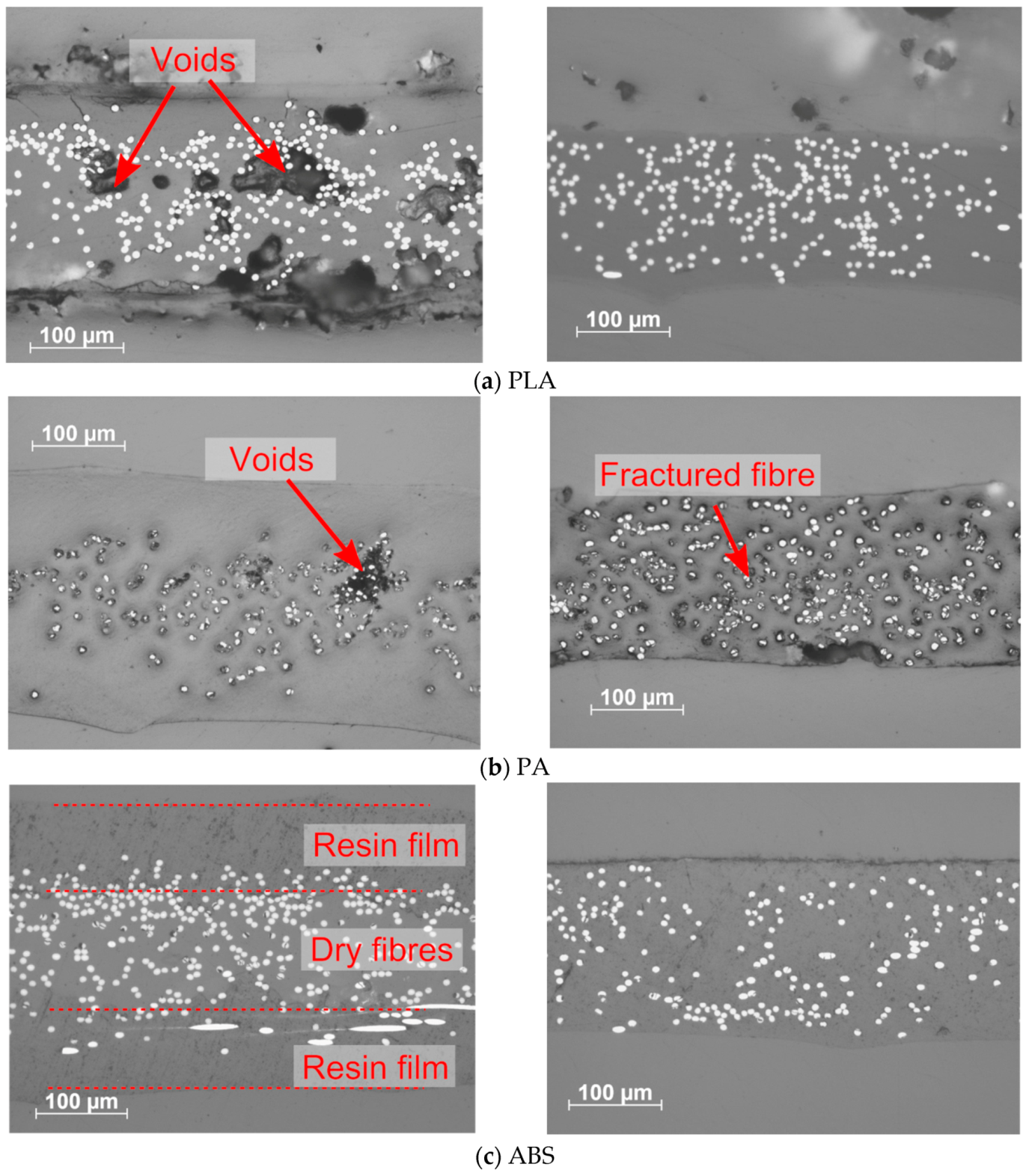

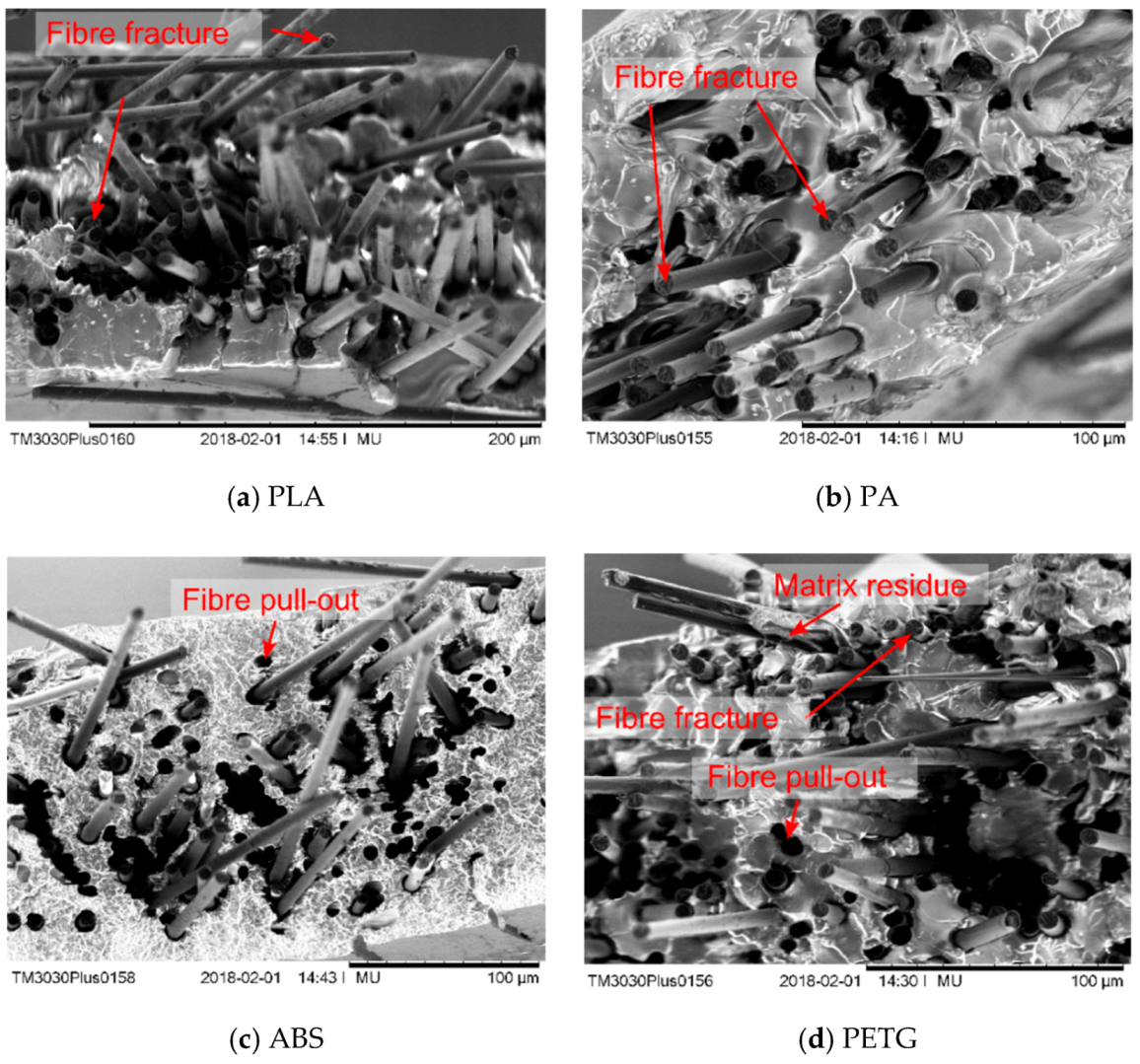
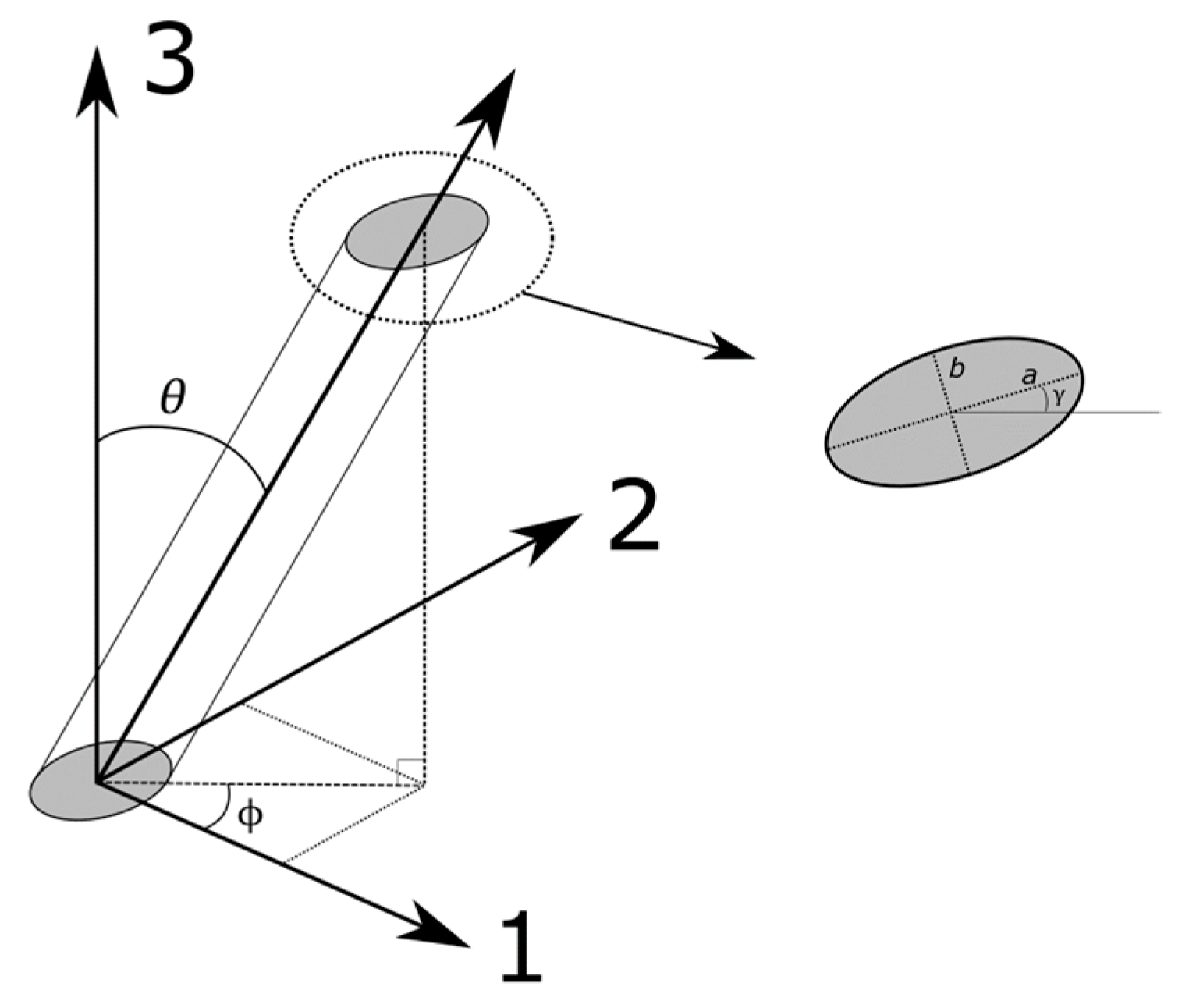
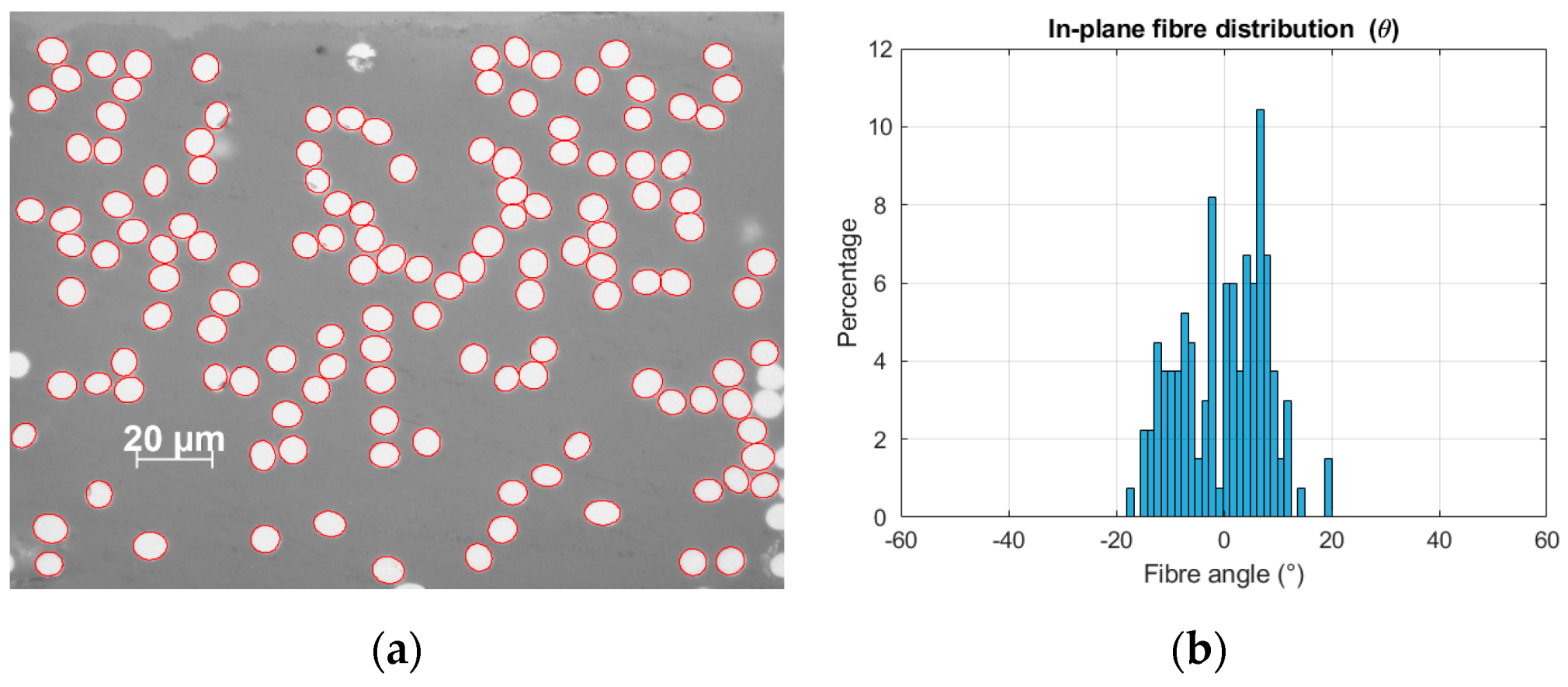
| Explanation | PA | PLA | ABS | PETG | PP | PCL | PC | LDPE | HDPE | PVC | PBT | PEI | PEEK | PPS | PSU | PESU | |
|---|---|---|---|---|---|---|---|---|---|---|---|---|---|---|---|---|---|
| Other names | Commercial and/or full name | Polyamide (Nylon) | Poly lactic acid | Acrylonitrile butadiene styrene | Poly ethylene terephthalate glycol | Poly propylene | Poly caprolactone | Poly carbonate | Low-density poly ethylene | High-density poly ethylene | Poly vinyl chlorid | Poly butylene terephthalate | Polyetherimide (Ultem) | Poly ether ether ketone | Poly phenylene sulfide | Polysulfone | Polyether-sulfone |
| Structure | Can be important to derive adhesion to fibres |  |  |  |  |  |  |  |  |  |  |  |  |  |  |  |  |
| Strength /stiffness | Mechanical properties | 0.94–1.18 GPa 38.6–48.2 MPa [33] | 2.3–2.6 GPa 38–68 MPa [33] | 2–2.9 GPa 29.6–44.1 MPa [33] | 2.01–2.11 GPa 47.9–52.9 MPa [33] | 1.34-1.59 GPa 32.9–36.4 MPa [33] | 0.39–0.44 GPa 21.1–38.5 MPa [33] | 2.32–2.44 GPa 59.1–65.2 MPa [33] | 0.17–0.28 GPa 8.96–14.5MPa [33] | 1.07–1.09 GPa 26.2–31 MPa [33] | 2.48–3.3 GPa 41.4–52.7 MPa [33] | 1.93–3 GPa 56.5–60 MPa [33] | 2.89–3.04 GPa 73.5–81.1 MPa [33] | 3.79–3.95 GPa 87–95 MPa [33] | 3.23–3.39 GPa 64–67.2 MPa [33] | 2.62–2.76 GPa 94.4–104 MPa [33] | 2.76–2.9 GPa 85.4–94.1 MPa [33] |
| Density | Density | 1060–1080 kg/m3 [33] | 1110–1210 kg/m3 [33] | 1020–1080 kg/m3 [33] | 1260–1280 kg/m3 [33] | 899–908 kg/m3 [33] | 1140–1150 kg/m3 [33] | 1190–1210 kg/m3 [33] | 914–932 kg/m3 [33] | 952–965 kg/m3 [33] | 1300–1490 kg/m3 [33] | 1300–1380 kg/m3 [33] | 1260–1280 kg/m3 [33] | 1300–1320 kg/m3 [33] | 1340–1360 kg/m3 [33] | 1230–1250 kg/m3 [33] | 1360–1380 kg/m3 [33] |
| Costs | Lower cost better | 2.35–2.53 GBP/kg [33] | 2.34–3.01 GBP/kg [33] | 1.82–2.15 GBP/kg [33] | 1.98–2.06 GBP/kg [1] | 1.1–1.14 GBP/kg [33] | 5.73–8.32 GBP/kg [33] | 2.57–2.75 GBP/kg [33] | 1.32–1.35 GBP/kg [33] | 1.22–1.25 GBP/kg [33] | 1.06–1.21 GBP/kg [33] | 1.98–2.06 GBP/kg [33] | 13.4 GBP/kg [33] | 75 GBP/kg [33] | 4.83–5.23 GBP/kg [33] | 7.53–10.9 GBP/kg [33] | 8.73–9.26 GBP/kg [33] |
| Glass transition temperature | High glass transition temperature for usage | ~60 °C [33] | 52–82.6 °C [33] | 88–120 °C [33] | 81–91 °C [33] | −14, −6 °C [33] | −72, −59 °C [33] | 142–158 °C [33] | −125, −90 °C [33] | −125, −90 °C [33] | 80–88 °C [33] | 22–43 °C [33] | 215–217 °C [33] | 143–157 °C [33] | 81–97 °C [33] | 186–192 °C [33] | 210–235 °C [33] |
| Processing temperature | Lower processing temperature is easier/cheaper | 220–327 °C [33] | 170–210 °C [33] | 177–260 °C [33] | 249–288 °C [33] | 203–250 °C [33] | 106–133 °C [33] | 205–298 °C [33] | 121–232 °C [33] | 177–274 °C [33] | 177–199 °C [33] | 184–274 °C [33] | 309–430 °C [33] | 349–399 °C [33] | 257–338 °C [33] | 273–360 °C [33] | 295–391 °C [33] |
| Coefficient thermal expansion (CTE) | Low thermal expansion to prevent warpage | 141–147 μstrain/°C [33] | 126–145 μstrain/°C [33] | 128–234 μstrain/°C [33] | 120–123 μstrain/°C [33] | 81.1–109 μstrain/°C [33] | 158–172 μstrain/°C [33] | 120–125 μstrain/°C [33] | 180–396 μstrain/°C [33] | 106–198 μstrain°C [33] | 90–180 μstrain/°C [33] | 108–171 μstrain/°C [33] | 84.6–101 μstrain/°C [33] | 50–60 μstrain/°C [33] | 48.6–88.2 μstrain/°C [33] | 54.7–56.9 μstrain/°C [33] | 54.7–56.9 μstrain/°C [33] |
| Thermal conductivity | High thermal conductivity, easy to heat up and redistribute heat for polymer sintering | 0.24–0.32 W/m°C [33] | 0.13–0.16 W/m°C [33] | 0.266–0.235 W/m°C [33] | 0.257–0.267 W/m°C [33] | 0.205–0.214 W/m°C [33] | 0.17–0.18 Wm/°C [33] | 0.193–0.218 W/m°C [33] | 0.322–0.348 W/m°C [33] | 0.461–0.502 W/m°C [33] | 0.147–0.209 W/m°C [33] | 0.274–0.285 W/m°C [33] | 0.123–0.13 W/m°C [33] | 0.24–0.26 Wm/°C [33] | 0.23–0.29 Wm/°C [33] | 0.277–0.288 Wm/°C [33] | 0.291–0303 Wm/°C [33] |
| Specific heat capacity | Higher is better, more heat can be added in the system when extruding | 1.65e3–1.71e3 J/kg°C [33] | 1.18e3–1.21e3 J/kg°C [33] | 1.39e3–1.41e3 J/kg°C [33] | 1.47e3–1.53e3 J/kg°C [33] | 1.66e3–1.7e3 J/kg°C [33] | 1.42e3–1.5e3 J/kg°C [33] | 1.15e3–1.25e3 J/kg°C [33] | 1.84e3–1.92e3 J/kg°C [33] | 1.75e3–1.81e3 J/kg°C [33] | 1e3–1.1e3 J/kg°C [33] | 1.42e3–1.48e3 J/kg°C [33] | 1.47e3–1.53e3 J/kg°C [33] | 1.34e3 J/kg°C [33] | 1.41e3–1.47e3 J/kg°C [33] | 1.5e3–1.53e3 J/kg°C [33] | 1.4e3–1.45e3 J/kg°C [33] |
| Crystallinity | Lower is better, want to print viscous and better bonding [31] | Semi-crystalline | Semi-crystalline | Amorphous | Amorphous | Semi-crystalline | Semi-crystalline | Amorphous | Semi-crystalline | High level of crystallinity | Semi-crystalline | Semi-crystalline | Amorphous | Semi-crystalline | Semi-crystalline | Amorphous | Amorphous |
| Shrinkage | Low shrinkage from melt to prevent warpage | 1.2-1.8 % [33] | 0.3–0.4% [33] | 0.4–0.7% [33] | 0.2–0.5% [33] | 1.4–1.95% [33] | 0.15–0.7% [33] | 0.5–0.7% [33] | 1.5–5% [33] | 1.5–4% [33] | 0.2–0.6% [33] | 0.9–2.2% [33] | 0.5–0.7% [33] | 1–1.21% [33] | 0.6–1.4% [33] | 0.5–0.7% [33] | 0.7–1% [33] |
| Molding pressure | Used as it is related to viscosity | 6.88–172 (89.44) MPa | 55–100 (77.5) MPa | 55–172 (113.5) MPa | 6.88–138 (72.44) MPa | 18–115 (66.5) MPa | 50–52 (51) MPa | 55–138 (96.5) MPa | 34.3–103 (68.65) MPa | 82–103 (92.5) MPa | 68.8–275 (171.9) MPa | 27.5–68.8 (48.15) MPa | 69–138 (103.5) MPa | 68.8–138 (103.4) MPa | 13.8–20.6 (17.2) MPa | 34.4–138 (86.2) MPa [33] | 41.3–138 (89.7) MPa [33] |
| Printing capability | Check proven 3D printing capability | Higher printing temperature than PLA/ABS, needs to be dry. | Good printing characteristics. | Good printing characteristics. | Good printing characteristics. | Hard to print. Warping problems due to high crystallinity. | Seems good, multiple reports on 3D printing of PCL. | Printing demonstrated, quite high temperatures. | Can be used for printing, but quite hard only stick to itself and stringy and warps. | Can be used for printing, but quite hard only stick to itself and stringy and warps. | Good printing demonstrated but safety and health issues. | Often used as additive for better printing, not available in filament itself. | Good, high performance 3D printing material. | Been demonstrated, high temperatures though. | Printing demonstrated, again high temperatures. | Printing filament on the market | Printing filament on the market |
| Interfacial properties w. carbon fibre | Better interface properties for both mechanical performance and consolidation | IFSS of 19.3 MPa [34] | IFSS of 11-19 MPa [35] | Less than PA6, as PA6 improves adhesion [36] | Less than Nylon; carbon PETG filament has a lower strength than carbon Nylon filament [37] | Poor based on molecular structure | Strength reported of 1000 MPa (with nanodiamonds) [38] | IFSS of 20 MPa [39] | No studies found, expected low from molecular structure | No studies found, expected low from molecular structure | No studies found, expected low from molecular structure | Paper used coupling agent which was needed for interfacial adhesion [40] | IFSS of 100 MPa [41] | Similar to epoxy, IFSS around 80 MPa [42] | IFSS of around 40 MPa [43] | IFSS of around 50 MPa [44] | IFSS of around 50 MPa [44] |
| Good property | Medium property | Poor property | |||||||||||||||
| Criteria | Weighting (%) | ABS | PETG | PLA | PBT | PCL | PSU | PESU | PA | LDPE | PP | PC | PEI | PVC | PPS | PEEK | HDPE |
|---|---|---|---|---|---|---|---|---|---|---|---|---|---|---|---|---|---|
| Processing temperature | 12.5 | 3 | 2 | 3 | 3 | 3 | 1 | 1 | 2 | 3 | 3 | 1 | 1 | 3 | 1 | 1 | 2 |
| Molding pressure | 12.5 | 1 | 2 | 2 | 3 | 3 | 1 | 1 | 2 | 3 | 3 | 1 | 1 | 1 | 1 | 1 | 1 |
| Costs | 10.0 | 3 | 3 | 3 | 3 | 2 | 2 | 2 | 3 | 3 | 3 | 3 | 2 | 3 | 2 | 1 | 3 |
| Glass transition temperature | 7.5 | 2 | 2 | 2 | 2 | 1 | 3 | 3 | 2 | 1 | 1 | 3 | 3 | 2 | 2 | 3 | 1 |
| Coefficient thermal expansion (CTE) | 7.5 | 2 | 2 | 2 | 2 | 1 | 3 | 3 | 2 | 1 | 3 | 2 | 2 | 2 | 3 | 3 | 2 |
| Thermal conductivity | 7.5 | 2 | 2 | 1 | 2 | 1 | 3 | 3 | 2 | 3 | 1 | 2 | 2 | 2 | 2 | 2 | 3 |
| Shrinkage | 7.5 | 3 | 3 | 3 | 1 | 3 | 3 | 3 | 2 | 2 | 2 | 3 | 3 | 3 | 2 | 2 | 2 |
| Printing capability | 7.5 | 3 | 3 | 3 | 2 | 3 | 3 | 3 | 2 | 2 | 2 | 2 | 3 | 2 | 2 | 2 | 2 |
| Interfacial properties w. carbon fibre | 7.5 | 2 | 2 | 2 | 2 | 3 | 3 | 3 | 3 | 1 | 1 | 3 | 3 | 1 | 3 | 3 | 1 |
| Specific heat capacity | 7.5 | 2 | 2 | 1 | 2 | 2 | 2 | 2 | 2 | 3 | 2 | 1 | 2 | 1 | 2 | 2 | 3 |
| Density | 5.0 | 3 | 2 | 3 | 2 | 3 | 2 | 2 | 3 | 1 | 1 | 3 | 2 | 2 | 2 | 2 | 1 |
| Crystallinity | 5.0 | 3 | 3 | 2 | 2 | 2 | 3 | 3 | 2 | 2 | 2 | 3 | 3 | 2 | 2 | 2 | 1 |
| Strength/stiffness | 2.5 | 3 | 3 | 3 | 3 | 1 | 3 | 3 | 2 | 1 | 2 | 3 | 3 | 3 | 3 | 3 | 2 |
| TOTAL SCORE (/100): | 79.2 | 77.5 | 76.7 | 76.7 | 75.8 | 75.8 | 75.8 | 74.2 | 73.3 | 71.7 | 70.8 | 70.8 | 68.3 | 64.2 | 63.3 | 62.5 | |
| Good property | Medium property | Poor property | |||||||||||||||
| Cut Length | Density | Filament Diameter | Tensile Strength | Tensile Modulus |
|---|---|---|---|---|
| 3 mm | 1.82 g/cm3 | 7 μm | 4344 MPa | 225 GPa |
| Material | Tlow | Thigh |
|---|---|---|
| PLA | 170 °C | 210 °C |
| Nylon | 200 °C | 260 °C |
| ABS | 177 °C | 260 °C |
| PETG | 249 °C | 288 °C |
| Material | Temperature | Modulus (GPa) | CoV (%) | Stress (MPa) | CoV (%) | Failure Strain (%) | CoV (%) |
|---|---|---|---|---|---|---|---|
| PLA | Low | 24.15 | 16.71 | 274.68 | 11.39 | 1.12 | 9.76 |
| High | 28.00 | 13.69 | 351.54 | 22.64 | 1.20 | 15.45 | |
| PA | Low | 15.71 | 10.67 | 215.83 | 8.45 | 1.41 | 3.85 |
| High | 14.95 | 8.23 | 166.79 | 10.98 | 1.08 | 1.58 | |
| ABS | Low | 11.24 | 8.63 | 76.76 | 17.08 | 0.70 | 11.93 |
| High | 21.04 | 10.23 | 294.73 | 13.40 | 1.32 | 15.84 | |
| PETG | Low | 27.12 | 3.05 | 300.49 | 14.61 | 1.09 | 12.54 |
| High | 25.94 | 6.30 | 309.36 | 7.76 | 1.12 | 11.05 |
Publisher’s Note: MDPI stays neutral with regard to jurisdictional claims in published maps and institutional affiliations. |
© 2020 by the authors. Licensee MDPI, Basel, Switzerland. This article is an open access article distributed under the terms and conditions of the Creative Commons Attribution (CC BY) license (http://creativecommons.org/licenses/by/4.0/).
Share and Cite
Blok, L.G.; Longana, M.L.; Woods, B.K.S. Fabrication and Characterisation of Aligned Discontinuous Carbon Fibre Reinforced Thermoplastics as Feedstock Material for Fused Filament Fabrication. Materials 2020, 13, 4671. https://doi.org/10.3390/ma13204671
Blok LG, Longana ML, Woods BKS. Fabrication and Characterisation of Aligned Discontinuous Carbon Fibre Reinforced Thermoplastics as Feedstock Material for Fused Filament Fabrication. Materials. 2020; 13(20):4671. https://doi.org/10.3390/ma13204671
Chicago/Turabian StyleBlok, Lourens Gerrit, Marco Luigi Longana, and Benjamin King Sutton Woods. 2020. "Fabrication and Characterisation of Aligned Discontinuous Carbon Fibre Reinforced Thermoplastics as Feedstock Material for Fused Filament Fabrication" Materials 13, no. 20: 4671. https://doi.org/10.3390/ma13204671
APA StyleBlok, L. G., Longana, M. L., & Woods, B. K. S. (2020). Fabrication and Characterisation of Aligned Discontinuous Carbon Fibre Reinforced Thermoplastics as Feedstock Material for Fused Filament Fabrication. Materials, 13(20), 4671. https://doi.org/10.3390/ma13204671






